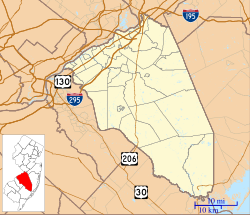Francis Hopkinson House | |
 Francis Hopkinson House in 2017 | |
| Location | 101 Farnsworth Avenue (CR 545), Bordentown, New Jersey |
|---|---|
| Coordinates | 40°8′54″N74°42′50″W / 40.14833°N 74.71389°W |
| Built | 1750 |
| Architect | John Imlay |
| NRHP reference No. | 71000496 [1] |
| NJRHP No. | 75 [2] |
| Significant dates | |
| Added to NRHP | July 17, 1971 |
| Designated NHL | July 17, 1971 [3] |
| Designated NJRHP | July 17, 1971 |
The Francis Hopkinson House is an historic house at 101 Farnsworth Avenue in the city of Bordentown in Burlington County, New Jersey, United States. Built in 1750, it was the home of Founding Father Francis Hopkinson (1737-1791), the designer of the United States Flag and a signer of the United States Declaration of Independence. [4] He lived in this home with his wife Ann Borden (1747-1827) [5] from 1774 until Hopkinson's death in 1791. [6] Ann Borden was the granddaughter of Joseph Borden, the founder of Bordentown, New Jersey. [7] The house was designated a National Historic Landmark in 1971. [3]



